Introduction: In this article, Melissa Davenport Berry writes more about the men falsely accused of robbing the Nantucket Bank on Nantucket Island, Massachusetts, in 1795. Melissa is a genealogist who has a blog, AnceStory Archives, and a Facebook group, New England Family Genealogy and History.
Today I continue with my story on William Coffin (1756-1835), the spook who haunts his Nantucket home according to local lore. It is believed Coffin’s spirit cannot rest because he had been wrongly implicated in the 1795 Nantucket Bank Robbery.

One sighting of Coffin’s specter came from Peter Benchley, author of the thriller Jaws, who spent a summer on Nantucket Island in the specter’s home and saw the ghost. You can read all about it in Part 1 of this series.
To recap: Part 2 of this series revealed the real bank robbers: Captain John Clark Jr., Zeb Withers, and Sam Johnson – though their guilt was not brought to light until years later. While the true bandits remained free from the law, certain parties in the community targeted William Coffin and other bank officers.

This article reported:
The persons tried at Boston last week, for robbing the bank of Nantucket, were the Hon. Jethro Hussey, Esq. and Mess. Albert Gardner, William Coffin, [and] Samuel Barker, Jun., who were acquitted; and Randall Rice, who was found guilty, in favor of whom an arrest of judgment is moved: sentence is postponed to February next, during which time he [Rice] is confined, being unable to procure 60,000 dollars bail.
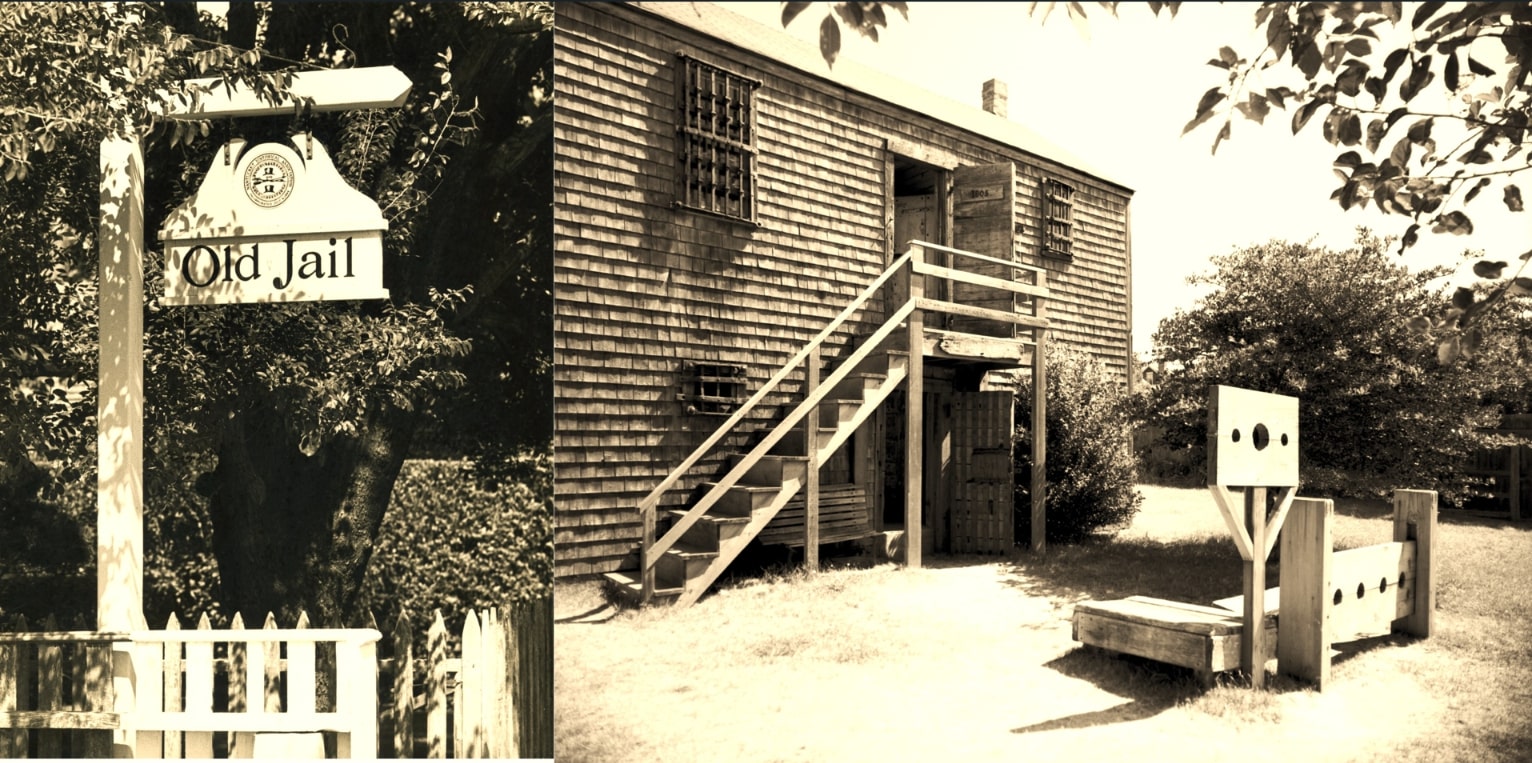
Diarist Kezia Coffin Fanning (1759-1820), born to John Coffin and “She Merchant” Kezia Folger, was married to Randall Rice’s attorney Phineas Fanning. Here are two of her diary entries from 1797, concerning the trial of Rice and his subsequent jailing.
In this first diary entry, Fanning shows her sympathy to Rice’s plight.
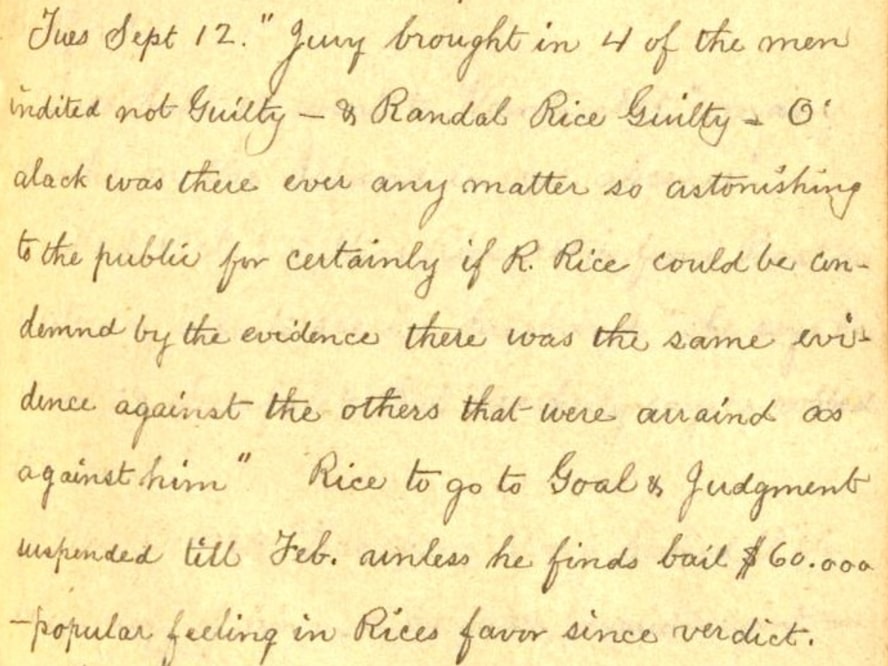
Here is a transcription:
Tues. Sept. 12. Jury brought in 4 of the men indited not guilty. Randal Rice guilty. O alack was there ever any matter so astonishing to the public, for certainly if R. Rice could be condemned by the evidence, there was the same evidence against the others that were arraigned as against him. Rice to go to goal [jail] and judgment suspended till Feb. unless he finds bail $60,000. Popular feeling in Rice’s favor since verdict.
In this second diary entry, Fanning writes of her visit to Rice in jail.

Here is a transcription:
Thurs. Sept. 14. Went to see Rice in prison. He is in the criminal part [with] a man in the same room. He appears as cheerful as can be expected [for] a man to be in his situation. Weatherly, that broke [out of] goal here last year, was there in a room near Rice.
Rice appealed to Governor Increase Sumner for a pardon, and when Sumner read the facts of the case (which showed the identity of the real robbers and some of the machinations of the bankers), the governor granted the pardon. (Nantucket: The Life of an Island, Edwin P. Hoyt, p. 80.)
Here is a newsclip announcing his pardon.
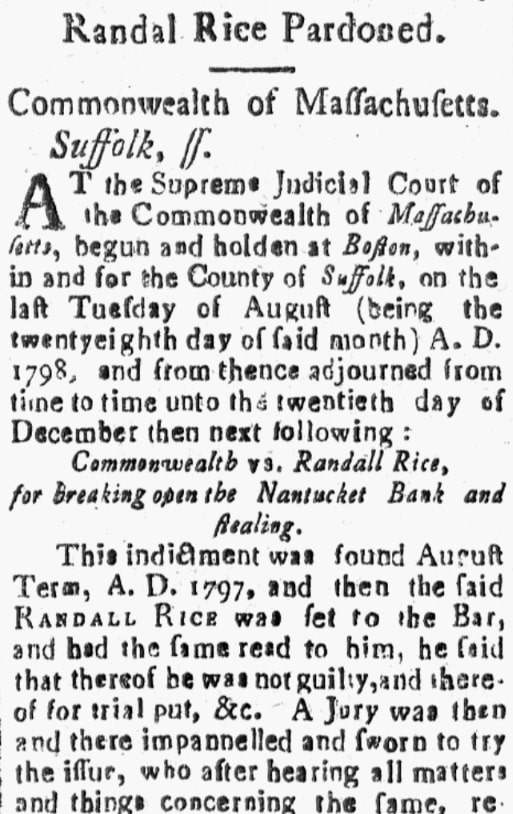
William Coffin was not the only soul tormented by this wrongful accusation. When Jethro Hussey died the newspapers published a letter dictated by him in his very last days, which made a telling assessment of the effect this robbery had on the departed, his fellow falsely-accused victims, and the community.
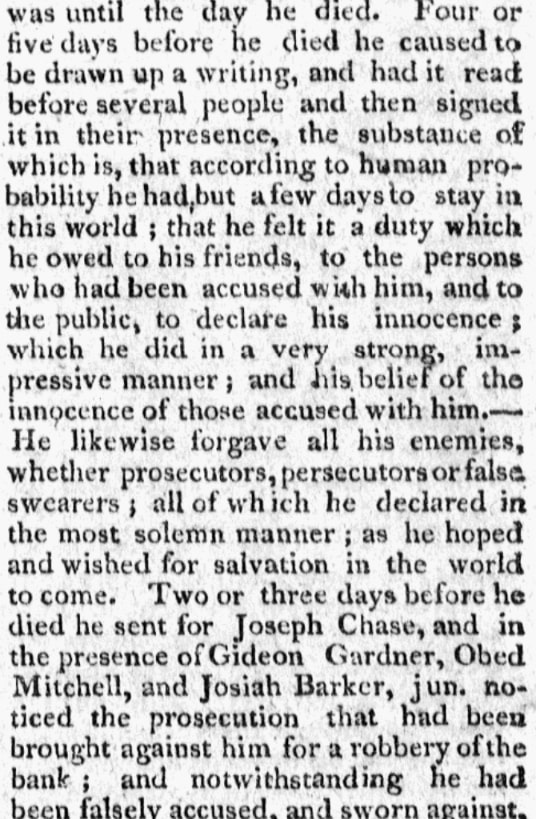
This article reported:
In our last we announced the death at Nantucket of the Hon. Jethro Hussey, judge of probate for the county of Nantucket. He was one of those persons, accused and acquitted, some years since, of the robbery of the Nantucket Bank. The prosecution which took place, in consequence of the robbery, must be in the recollection of our readers. Before the death of the gentleman mentioned above, some circumstances occurred, which are narrated in letters from that island, and which concur with the general sentiment of the innocence of the then accused.
One letter, dated Feb. 12, 1808, says, “About a week before he (Judge Hussey) died, he was fully sensible of his situation as long as he retained the faculty of speech, which was until the day he died.
Four or five days before he died, he caused to be drawn up a writing, and had it read before several people and then signed it in their presence, the substance of which is, that according to human probability he had but a few days to stay in this world; that he felt it a duty which he owed to his friends, to the persons who had been accused with him, and to the public, to declare his innocence; which he did in a very strong, impressive manner, and his belief of the innocence of those accused with him.
He likewise forgave all his enemies, whether prosecutors, persecutors, or false swearers; all of which he declared in the most solemn manner, as he hoped and wished for salvation in the world to come.
Two or three days before he died he sent for Joseph Chase, and in the presence of Gideon Gardner, Obed Mitchell, and Josiah Barker, Jun., noticed the prosecution that had been brought against him for a robbery of the bank; and not withstanding he had been falsely accused, and sworn against, harassed, and evilly treated to the loss of friends and property, still he felt it a duty, which he owed to God, to forgive everybody, whether they believed, or did not believe, or whatever were their motives in prosecuting him.
All, he said, were alike to him now; he forgave them, and declared his innocence to Chase in the strongest terms. The persons present say that Chase gave a becoming attention to his conversation, but did not say whether he believed him or not.
My opinion is, that he believed him; for none but a wretch could help believing.
What will be said of those persons who have been at the bottom of the mischief I know not; but the words of a dying man are stubborn things to get over.
Gideon Gardner (1759-1832), one of the friends gathered to hear Jethro Hussey’s last words, was the son of Hezekiah Gardner and Sarah Folger. He was a ship owner and U.S. Representative of Massachusetts.
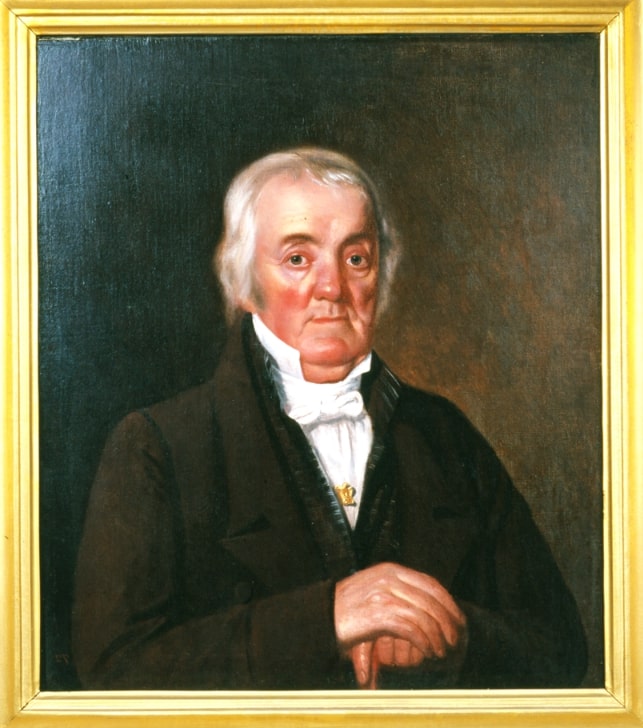
The genealogy of the subjects in this article can be viewed on the Nantucket Historical Society website compiled by Eliza Starbuck Barney, aka “Mother of Island Genealogy.”
Here are two examples:
- Jethro Hussey, born to George Hussey and Elizabeth Starbuck, married Margaret Coffin, daughter of James Coffin and Priscilla Rawson.
- Obed Mitchell, born to Jethro Mitchell and Rachel Hussey, married Lydia Gardner, daughter of Paul Gardner and Rachel Starbuck.
Stay tuned for more drama featuring a horoscope that helps seal the indictment of William Coffin and the others – plus the war of the Quaker families.
Explore over 330 years of newspapers and historical records in GenealogyBank. Discover your family story! Start a 7-Day Free Trial
Note on the header image: 1870s Nantucket street scene by C. H. Shute & Son of Edgartown, Massachusetts. Credit: Wikimedia Commons.
Related Articles:
